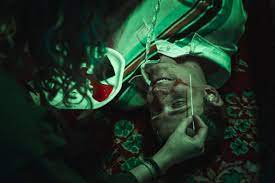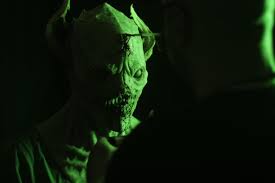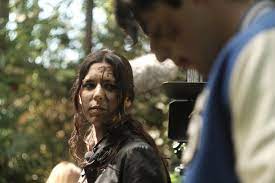🎬 The Book of the Dead (2024)

The Book of the Dead (2024) Review
The Book of the Dead (2024), directed by acclaimed filmmaker Ana Lopez, is a haunting and visually stunning exploration of life, death, and the thin veil separating the two. Drawing inspiration from ancient mythology and modern existentialism, the film weaves a narrative that is as intellectually provocative as it is emotionally stirring.
Plot Overview
The story follows Sophia (Tessa Thompson), a grieving anthropologist who stumbles upon an ancient text known as “The Book of the Dead.” This mystical artifact purportedly holds the power to bridge the worlds of the living and the dead. Driven by guilt and longing after the death of her younger brother, Leo (Jordan Fisher), Sophia embarks on a perilous journey to uncover the secrets of the book and reunite with her lost sibling.
As Sophia delves deeper into the text, she encounters Marcus (Oscar Isaac), a mysterious and tormented figure who claims to have used the book to communicate with his deceased wife. Together, they navigate a surreal and dangerous landscape where memories, dreams, and reality intertwine. Along the way, Sophia must confront the consequences of tampering with the natural order and decide whether the cost of crossing the boundary between life and death is worth the potential reward.
Tessa Thompson delivers a tour-de-force performance as Sophia, capturing the character’s grief, determination, and vulnerability with remarkable depth. Her portrayal grounds the fantastical elements of the story, making Sophia’s journey both relatable and heart-wrenching.
Oscar Isaac brings complexity and gravitas to Marcus, a character torn between hope and despair. His chemistry with Thompson adds layers to their interactions, elevating the emotional stakes of the narrative.
Jordan Fisher’s portrayal of Leo, though limited in screen time, leaves a lasting impression. His presence, primarily in flashbacks and dreamlike sequences, serves as a poignant reminder of Sophia’s loss and the emotional core of the film.
Visuals and Atmosphere
One of The Book of the Dead’s standout features is its visual design. Cinematographer Rachel Morrison masterfully blends vibrant, otherworldly imagery with stark, grounded realism. The film’s depiction of the liminal space between life and death is both breathtaking and unsettling, with surreal landscapes and eerie, dreamlike sequences that linger in the mind.
The production design, by Hannah Beachler, seamlessly integrates elements of ancient symbolism and modern aesthetics, creating a world that feels timeless yet specific. The use of shadow and light underscores the film’s themes, with scenes often bathed in ethereal glows or plunged into foreboding darkness.
Themes and Writing
At its core, The Book of the Dead is a meditation on grief, memory, and the human desire to defy mortality. The screenplay, penned by Lopez and co-writer Jonathan Banks, balances philosophical musings with a compelling narrative, inviting viewers to ponder profound questions about life and loss without losing sight of the story’s emotional resonance.
The dialogue is thoughtful and poetic, often reflecting the characters’ inner turmoil and existential dilemmas. While some sequences lean heavily into abstract symbolism, they are anchored by the characters’ emotional journeys, ensuring that the film remains accessible despite its intellectual ambitions.
Strengths and Weaknesses
The film’s greatest strength lies in its ability to balance spectacle with substance. The stunning visuals and intricate world-building are matched by a deeply personal and emotionally resonant story. Thompson’s performance and the nuanced exploration of grief make Sophia’s journey universally relatable, even as the film delves into fantastical territory.
However, the deliberate pacing and abstract narrative structure may not appeal to all viewers. The film’s reliance on visual storytelling and symbolism occasionally leaves certain plot points feeling ambiguous, which could frustrate those seeking a more straightforward narrative. Additionally, while the supporting cast delivers strong performances, some characters feel underutilized, leaving potential subplots unexplored.
Soundtrack and Sound Design
The haunting score by Hildur Guðnadóttir perfectly complements the film’s tone, blending ethereal melodies with dissonant, unsettling sounds. The sound design further enhances the immersive experience, with whispers, echoes, and atmospheric effects that draw viewers into the film’s otherworldly realms.
Conclusion
The Book of the Dead (2024) is a visually mesmerizing and emotionally profound film that challenges audiences to confront the complexities of grief and the limits of human ambition. With stellar performances, stunning visuals, and a thought-provoking narrative, it stands as a bold and unforgettable entry in the modern fantasy genre.
While its abstract storytelling and deliberate pacing may not resonate with everyone, those willing to embrace its introspective and symbolic nature will find a cinematic experience that lingers long after the credits roll. For fans of visually driven and thematically rich storytelling, The Book of the Dead is a must-watch.